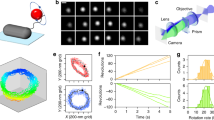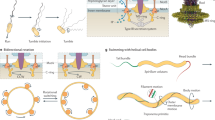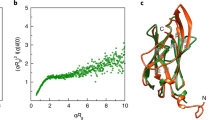Abstract
Motile archaea swim using a rotary filament, the archaellum, a surface appendage that resembles bacterial flagella structurally, but is homologous to bacterial type IV pili. Little is known about the mechanism by which archaella produce motility. To gain insights into this mechanism, we characterized archaellar function in the model organism Halobacterium salinarum. Three-dimensional tracking of quantum dots enabled visualization of the left-handed corkscrewing of archaea in detail. An advanced analysis method combined with total internal reflection fluorescence microscopy, termed cross-kymography, was developed and revealed a right-handed helical structure of archaella with a rotation speed of 23 ± 5 Hz. Using these structural and kinetic parameters, we computationally reproduced the swimming and precession motion with a hydrodynamic model and estimated the archaellar motor torque to be 50 pN nm. Finally, in a tethered-cell assay, we observed intermittent pauses during rotation with ∼36° or 60° intervals, which we speculate may be a unitary step consuming a single adenosine triphosphate molecule, which supplies chemical energy of 80 pN nm when hydrolysed. From an estimate of the energy input as ten or six adenosine triphosphates per revolution, the efficiency of the motor is calculated to be ∼6–10%.
This is a preview of subscription content, access via your institution
Access options
Subscribe to this journal
Receive 12 digital issues and online access to articles
$119.00 per year
only $9.92 per issue
Buy this article
- Purchase on Springer Link
- Instant access to full article PDF
Prices may be subject to local taxes which are calculated during checkout






Similar content being viewed by others
References
Jarrell, K. F. & McBride, M. J. The surprisingly diverse ways that prokaryotes move. Nat. Rev. Microbiol. 6, 466–476 (2008).
Berg, H. C. The rotary motor of bacterial flagella. Annu. Rev. Biochem. 72, 19–54 (2003).
Sowa, Y. & Berry, R. M. Bacterial flagellar motor. Q. Rev. Biophys. 41, 103–132 (2008).
Merz, A. J., So, M. & Sheetz, M. P. Pilus retraction powers bacterial twitching motility. Nature 407, 98–102 (2000).
Skerker, J. M. & Berg, H. C. Direct observation of extension and retraction of type IV pili. Proc. Natl Acad. Sci. USA 98, 6901–6904 (2001).
Ghosh, A., Hartung, S., van der Does, C., Tainer, J. A. & Albers, S. V. Archaeal flagellar ATPase motor shows ATP-dependent hexameric assembly and activity stimulation by specific lipid binding. Biochem. J. 437, 43–52 (2011).
Jarrell, K. F. & Albers, S. V. The archaellum: an old motility structure with a new name. Trends Microbiol. 20, 307–312 (2012).
Szabo, Z. et al. Identification of diverse archaeal proteins with class III signal peptides cleaved by distinct archaeal prepilin peptidases. J. Bacteriol. 189, 772–778 (2007).
Patenge, N., Berendes, A., Engelhardt, H., Schuster, S. C. & Oesterhelt, D. The fla gene cluster is involved in the biogenesis of flagella in Halobacterium salinarum. Mol. Microbiol. 41, 653–663 (2001).
Thomas, N. A., Mueller, S., Klein, A. & Jarrell, K. F. Mutants in flaI and flaJ of the archaeon Methanococcus voltae are deficient in flagellum assembly. Mol. Microbiol. 46, 879–887 (2002).
Reindl, S. et al. Insights into FlaI functions in archaeal motor assembly and motility from structures, conformations, and genetics. Mol. Cell 49, 1069–1082 (2013).
Alam, M. & Oesterhelt, D. Morphology, function and isolation of halobacterial flagella. J. Mol. Biol. 176, 459–475 (1984).
Marwan, W., Alam, M. & Oesterhelt, D. Rotation and switching of the flagellar motor assembly in Halobacterium halobium. J. Bacteriol. 173, 1971–1977 (1991).
Shahapure, R., Driessen, R. P., Haurat, M. F., Albers, S. V. & Dame, R. T. The archaellum: a rotating type IV pilus. Mol. Microbiol. 91, 716–723 (2014).
Yajima, J., Mizutani, K. & Nishizaka, T. A torque component present in mitotic kinesin Eg5 revealed by three-dimensional tracking. Nat. Struct. Mol. Biol. 15, 1119–1121 (2008).
Yamaguchi, S. et al. Torque generation by axonemal outer-arm dynein. Biophys. J. 108, 872–879 (2015).
Katoh, T. A., Fujimura, S. & Nishizaka, T. in Handbook of Photonics for Biomedical Engineering (eds Ho, A. H.-P., Kim, D. & Somekh, M. G.) (Springer, in the press).
Tsuji, T. et al. Single-particle tracking of quantum dot-conjugated prion proteins inside yeast cells. Biochem. Biophys. Res. Commun. 405, 638–643 (2011).
Kinosita, Y. et al. Unitary step of gliding machinery in Mycoplasma mobile. Proc. Natl Acad. Sci. USA 111, 8601–8606 (2014).
Masaike, T., Koyama-Horibe, F., Oiwa, K., Yoshida, M. & Nishizaka, T. Cooperative three-step motions in catalytic subunits of F1-ATPase correlate with 80° and 40° substep rotations. Nat. Struct. Mol. Biol. 15, 1326–1333 (2008).
Nishizaka, T. et al. Chemomechanical coupling in F1-ATPase revealed by simultaneous observation of nucleotide kinetics and rotation. Nat. Struct. Mol. Biol. 11, 142–148 (2004).
Cox, R. G. The motion of long slender bodies in a viscous fluid. Part 1. General theory. J. Fluid Mech. 44, 791–810 (1970).
Rodenborn, B., Chen, C. H., Swinney, H. L., Liu, B. & Zhang, H. P. Propulsion of microorganisms by a helical flagellum. Proc. Natl Acad. Sci. USA 110, E338–E347 (2013).
Oesterhelt, D. & Krippahl, G. Phototrophic growth of halobacteria and its use for isolation of photosynthetically-deficient mutants. Ann. Microbiol. 134B, 137–150 (1983).
Liu, B. et al. Helical motion of the cell body enhances Caulobacter crescentus motility. Proc. Natl Acad. Sci. USA 111, 11252 (2014).
Deschout, H. et al. Precisely and accurately localizing single emitters in fluorescence microscopy. Nat. Methods 11, 253–266 (2014).
Watanabe, N. & Mitchison, T. J. Single-molecule speckle analysis of actin filament turnover in lamellipodia. Science 295, 1083–1086 (2002).
Turner, L., Ryu, W. S. & Berg, H. C. Real-time imaging of fluorescent flagellar filaments. J. Bacteriol. 182, 2793–2801 (2000).
Darnton, N. C., Turner, L., Rojevsky, S. & Berg, H. C. On torque and tumbling in swimming Escherichia coli. J. Bacteriol. 189, 1756–1764 (2007).
Magariyama, Y. et al. Simultaneous measurement of bacterial flagellar rotation rate and swimming speed. Biophys. J. 69, 2154–2162 (1995).
Kireev, I. I., Novikova, T. M., Sheval, E. V. & Metlina, A. L. Structure of the intracellular part of the motility apparatus of halobacteria. Mikrobiologiia 75, 364–370 (2006).
Tokunaga, M., Kitamura, K., Saito, K., Iwane, A. H. & Yanagida, T. Single molecule imaging of fluorophores and enzymatic reactions achieved by objective-type total internal reflection fluorescence microscopy. Biochem. Biophys. Res. Commun. 235, 47–53 (1997).
Berg, H. C. & Anderson, R. A. Bacteria swim by rotating their flagellar filaments. Nature 245, 380–382 (1973).
Sowa, Y. et al. Direct observation of steps in rotation of the bacterial flagellar motor. Nature 437, 916–919 (2005).
Yasuda, R., Noji, H., Kinosita, K. Jr & Yoshida, M. F1-ATPase is a highly efficient molecular motor that rotates with discrete 120° steps. Cell 93, 1117–1124 (1998).
Armitage, J. P. & Schmitt, R. Bacterial chemotaxis: Rhodobacter sphaeroides and Sinorhizobium meliloti—variations on a theme? Microbiology 143, 3671–3682 (1997).
Son, K., Guasto, J. & Stocker, R. Bacteria can exploit a flagellar buckling instability to change direction. Nat. Phys. 9, 494–498 (2013).
Wang, F., Yuan, J. & Berg, H. C. Switching dynamics of the bacterial flagellar motor near zero load. Proc. Natl Acad. Sci. USA 111, 15752–15755 (2014).
Shaevitz, J. W., Lee, J. Y. & Fletcher, D. A. Spiroplasma swim by a processive change in body helicity. Cell 122, 941–945 (2005).
Mehta, A. D. et al. Myosin-V is a processive actin-based motor. Nature 400, 590–593 (1999).
Svoboda, K., Schmidt, C. F., Schnapp, B. J. & Block, S. M. Direct observation of kinesin stepping by optical trapping interferometry. Nature 365, 721–727 (1993).
Nakamura, S., Kami-ike, N., Yokota, J. P., Minamino, T. & Namba, K. Evidence for symmetry in the elementary process of bidirectional torque generation by the bacterial flagellar motor. Proc. Natl Acad. Sci. USA 107, 17616–17620 (2010).
Chaudhury, P. et al. The nucleotide-dependent interaction of FlaH and FlaI is essential for assembly and function of the archaellum motor. Mol. Microbiol. 99, 674–685 (2015).
Tripepi, M., Imam, S. & Pohlschroder, M. Haloferax volcanii flagella are required for motility but are not involved in PibD-dependent surface adhesion. J. Bacteriol. 192, 3093–3102 (2010).
Kudo, S., Magariyama, Y. & Aizawa, S. Abrupt changes in flagellar rotation observed by laser dark-field microscopy. Nature 346, 677–680 (1990).
Yasuda, R., Noji, H., Yoshida, M., Kinosita, K. Jr & Itoh, H. Resolution of distinct rotational substeps by submillisecond kinetic analysis of F1-ATPase. Nature 410, 898–904 (2001).
Acknowledgements
The authors thank S.-V. Albers, M. Beeby, R. Kamiya, H. Noji and I. Sase for discussions that were critical in preparing the manuscript, and T. Minamino and Y.V. Morimoto for supplying Salmonella. This study was supported in part by the Funding Program for Next-Generation World-Leading Researchers Grant LR033 (to T.N.) from the Japan Society for the Promotion of Science (JSPS), by a Grant-in-Aid for Scientific Research on Innovative Areas (‘Fluctuation & Structure’ of JSPS KAKENHI grant nos. JP26103502 and JP16H00792 to N.U. and nos. JP26103527 and JP16H00808 to T.N.; ‘Cilia & Centrosomes’ of grant no. JP87003306 to T.N.; ‘Motility Machinery’ of grant no. JP15H01329 to D.N and no. JP24117002 to T.N.) from the Ministry of Education, Culture, Sports, Science and Technology of Japan, and by JSPS KAKENHI (grant no. JP16H06230 to D.N. and no. JP15H04364 to T.N.). Y.K is a recipient of a JSPS Fellowship for Japan Junior Scientists (no. JP15J12274).
Author information
Authors and Affiliations
Contributions
Y.K., N.U., D.N. and T.N. designed the research. Y.K. performed experimental work. N.U. developed a framework for computational calculations. Y.K. and T.N. constructed the optical set-up and microscope. Y.K. and T.N. performed data analyses. Y.K., N.U. and T.N. wrote the paper.
Corresponding authors
Ethics declarations
Competing interests
The authors declare no competing financial interests.
Supplementary information
Supplementary information
Supplementary Methods, Supplementary Results, Supplementary Figures 1-6, Supplementary Table 1, Legends for Supplementary Videos 1-11, Supplementary References (PDF 821 kb)
Supplementary Video 1
Swimming of Halobacterium salinarum observed under phase-contrast microscopy. (AVI 17759 kb)
Supplementary Video 2
Fluorescent image of QDs attached to the cell body observed under 3D tracking microscopy, termed as ‘three-dimensional prismatic optical tracking’ (AVI 591 kb)
Supplementary Video 3
Rotation of cell body and archaella simultaneously observed under fluorescent microscopy. (AVI 1300 kb)
Supplementary Video 4
Swimming of fluorescent-labelled cells observed under fluorescent microscopy. (AVI 7504 kb)
Supplementary Video 5
Hbt. salinarum with several flagellar filaments, each one rotating independently. (AVI 3300 kb)
Supplementary Video 6
Archaella rotation observed under TIRFM. (AVI 4389 kb)
Supplementary Video 7
Rotation of bacterial flagellum under TIRFM. Scale bar represents 2 μm. (AVI 2093 kb)
Supplementary Video 8
The reconstructed swimming motion of a single archaeon with observed parameters, based on slender-body theory. (MP4 350 kb)
Supplementary Video 9
Dark-field image of Hbt. salinarum tethered to the glass. (AVI 579 kb)
Supplementary Video 10
Dark-field image of Hbt. salinarum tethered to the glass. (AVI 391 kb)
Supplementary Video 11
Dark-field image of Hbt. salinarum tethered to the glass (AVI 4060 kb)
Rights and permissions
About this article
Cite this article
Kinosita, Y., Uchida, N., Nakane, D. et al. Direct observation of rotation and steps of the archaellum in the swimming halophilic archaeon Halobacterium salinarum. Nat Microbiol 1, 16148 (2016). https://doi.org/10.1038/nmicrobiol.2016.148
Received:
Accepted:
Published:
DOI: https://doi.org/10.1038/nmicrobiol.2016.148
This article is cited by
-
Promising dawn in tumor microenvironment therapy: engineering oral bacteria
International Journal of Oral Science (2024)
-
VA-TIRFM-based SM kymograph analysis for dwell time and colocalization of plasma membrane protein in plant cells
Plant Methods (2023)
-
Haloarchaea swim slowly for optimal chemotactic efficiency in low nutrient environments
Nature Communications (2020)
-
Distinct chemotactic behavior in the original Escherichia coli K-12 depending on forward-and-backward swimming, not on run-tumble movements
Scientific Reports (2020)
-
The 57th Annual Meeting of the Biophysical Society of Japan
Biophysical Reviews (2020)



